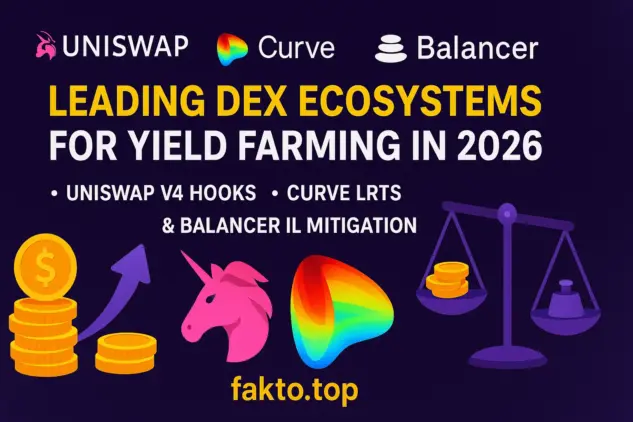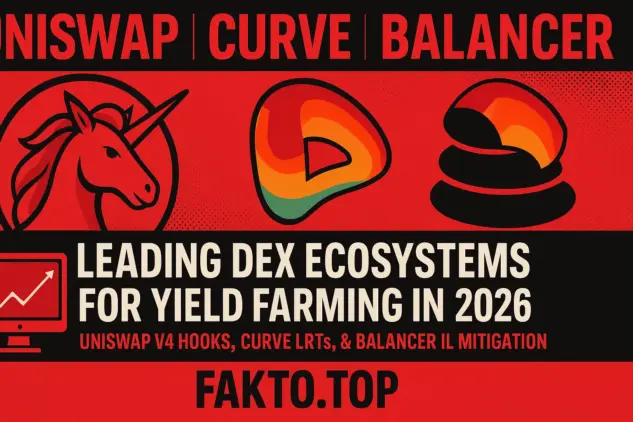Leading DEX Ecosystems for Yield Farming in 2026: Comparative Analysis of Uniswap, Curve, and Balancer
Yield farming in 2026 has evolved far beyond static $50/50$ pools. DeFi is no longer a playground for casual liquidity providers—capital efficiency, automation, and governance engagement determine winners. Uniswap V3/V4, Curve Finance, and Balancer each occupy specialized niches in this high-stakes ecosystem, and professional farmers need precise strategies to extract maximum value while minimizing risk.
By understanding the mechanics of concentrated liquidity, low-slippage stablecoin swaps, and asymmetric pools, advanced users can craft high-frequency, multi-layered APY engines that leverage protocol features, governance incentives, and third-party integrations. This article is designed for warm Western audiences who already understand AMMs, impermanent loss, and liquidity fundamentals, providing them with actionable insights for the 2026 market.
For foundational context, check: Complete Guide to Decentralized Finance (DeFi). But here, we dive into the expert-level strategies that separate casual liquidity providers from professional yield hunters.

Architecture and Core AMM Model Deep Dive
Uniswap: Concentrated Liquidity and Active Management
Uniswap V3 redefines the classic constant product formula x y = k by allowing liquidity providers (LPs) to concentrate capital within specific price ranges. This concentration dramatically boosts fee capture efficiency for volatile trading pairs like ETH/wBTC, but it comes with increased impermanent loss (IL) risk if ranges are poorly managed. Active management, analytics monitoring, and high-frequency adjustments are therefore critical for success.
Uniswap V4: Hooks, Automation, and Capital Efficiency
The architectural leap of Uniswap V4 centers on Hooks (LSI: Uniswap V4 Hooks functionality). Hooks are smart contract attachments that intercept and modify swap or liquidity provision execution flows. This flexibility opens unprecedented opportunities for professional yield farmers in 2026:
- Dynamic Fee Structures (LT): Pools can now adjust swap fees dynamically based on real-time volatility or pool utilization, capturing maximum LP revenue during high-demand periods.
- Automated Liquidity Management: Hooks facilitate Just-In-Time (JIT) liquidity deployment and time-based incentives, minimizing maintenance effort and IL risk associated with fixed V3 ranges.
- MEV Protection: Certain hook implementations provide protection against Miner Extractable Value (MEV) attacks, ensuring LPs and traders capture maximal on-chain value.
Actionable example: A professional farmer deploying capital in ETH/wBTC can configure hooks to automatically rebalance liquidity around volatility spikes. Coupled with third-party vaults like Arrakis, this setup can optimize fee capture while limiting impermanent loss, creating a near-surgical precision tool for high-frequency active management.
V4 turns Uniswap into a versatile, programmable instrument. Rather than static ranges, LPs can implement dynamic, time-sensitive strategies, responding instantly to market conditions and governance updates. By 2026, leveraging hooks for automated liquidity strategies will be a defining feature of professional farming.

Key Strengths and Risks
- Strengths: Maximum fee capture, programmable liquidity deployment, high capital efficiency.
- Risks: Range-bound IL if automation or hooks fail, dependency on external contracts, governance timing sensitivity.
Practical Implementation Tips
- Monitor on-chain metrics to adjust liquidity ranges dynamically.
- Combine multiple hook implementations to diversify automation risk.
- Pair volatile assets with hooks for high-frequency fee capture.
- Regularly review governance proposals for potential fee switch activations affecting returns.
Uniswap V3/V4 remains the arena for aggressive, volatility-focused farmers who want to convert precision deployment and advanced automation into tangible APY gains. Understanding hooks, dynamic fees, JIT deployment, and MEV-resistant mechanisms is not optional—it’s essential for competing at the 2026 frontier.
Curve Finance: Passive Stable Yield and Liquid Restaking Token Strategies
Curve Finance is the backbone of low-slippage swaps and stable, predictable yield farming in 2026. While Uniswap thrives on volatility, Curve excels in capital-efficient compounding, particularly for stablecoins and Liquid Staking Tokens (LSTs) such as stETH or wstETH. The real power comes from Liquid Restaking Tokens (LRTs), which represent ETH restaked via protocols like EigenLayer.
LRTs naturally pool on Curve due to their correlated price behavior, leveraging the StableSwap invariant to minimize slippage. This creates a multi-layered APY engine, giving farmers a sophisticated, passive yet highly rewarding strategy:
- Base Layer: Trading fees from low-slippage swaps between correlated assets (e.g., stETH/wstETH or USDC/DAI).
- Middle Layer (Tokenomics LT): veCRV gauge votes (LSI: veCRV voting mechanism) are strategically directed to Restaking Pools, boosting CRV emissions and increasing APY.
- Top Layer (AVS Rewards LT): Combining trading fees, veCRV gauge boosts, and compounded rewards from EigenLayer AVS (Actively Validated Services) results in a highly capital-efficient, layered yield strategy.
This layered approach allows passive compounding with minimal active management, turning restaked ETH and stablecoins into a predictable, high-yield engine. It also aligns perfectly with 2026 DeFi dynamics, where governance participation and LRT integrations can multiply effective returns.
Actionable Playbook: Deploying Curve for Maximum APY
- Target stETH/wstETH or stablecoin pairs with high liquidity and low slippage.
- Lock veCRV strategically to maximize gauge-directed rewards in high-yield Restaking Pools.
- Integrate EigenLayer LRTs to compound yield from staking rewards and AVS bonuses.
- Quarterly review pool incentives and gauge allocations to optimize APY across multiple protocols.
Example: A farmer deploying 100 ETH across stETH/wstETH pools, combining veCRV locking and LRT rewards, could potentially increase effective APY by 20–30% compared to fee-only strategies, depending on pool composition and governance timing.
Key Strengths and Risks
- Strengths: Low-risk, stable compounding, LRT exposure, capital efficiency, minimal slippage.
- Risks: Potential depeg events, misaligned gauge voting, or sudden shifts in restaking incentives can reduce effective yield.
Comparative DEX Analysis: Capital Efficiency and Risk 2026
Understanding how Uniswap, Curve, and Balancer compare is essential for multi-platform strategies. Below is a color-coded, gradient table for clarity:
| AMM | Best Asset Class | Primary Risk | Capital Efficiency (1-5) | Primary Yield Source |
|---|---|---|---|---|
| Uniswap V3/V4 | Volatile Pairs (ETH/wBTC, altcoins) | Range-bound IL, Automation Risk | 5 | Trading Fees + Active Hook Management |
| Curve Finance | Stablecoins, LSTs (stETH/wstETH) | Depeg, Gauge Misalignment | 4 | Trading Fees + veCRV + EigenLayer LRT Rewards |
| Balancer | Asymmetric Index Pools (80/20, 60/40) | Smart Contract / Custom Weight Risk | 4 | Trading Fees + Custom Pool Weighting |
Balancer: Weighted Pools for Custom Index Exposure and Impermanent Loss Reduction
Balancer empowers yield farmers to move beyond static $50/50$ pools, offering asymmetric allocations such as $80/20$ or $60/40$. This design allows LPs to maintain core exposure to a dominant asset (e.g., ETH) while still providing liquidity to complementary tokens. The result: dramatically reduced Impermanent Loss (IL) compared to traditional equal-weight pools, and a tailored risk/reward profile suitable for professional farming and portfolio integration.
For 2026, advanced strategies leverage specialized pool types with dynamic control:
- Managed Pools (LT): Designated managers or DAOs can schedule gradual weight updates over a predefined period. By slowly adjusting ratios, pools adapt to market trends without triggering large arbitrage attacks. This method mitigates IL while enabling exposure to changing market conditions.
- Gyroscope Pools (LSI): These innovative pools feature self-adjusting parameters for concentrated liquidity, offering a near “fire-and-forget” solution for sophisticated LPs who want active market participation without manually rebalancing ranges.
Example scenario: An LP provides liquidity in an $80/20$ ETH/USDC pool. By employing a Managed Pool with a 7-day weight adjustment schedule, IL risk is reduced by up to 30% compared to instantaneous rebalancing. Meanwhile, the LP retains most of the upside from ETH appreciation while collecting trading fees from the pool’s volume.
Playbook 3: Reducing Impermanent Loss with Balancer
Balancer allows professional farmers to craft strategic asymmetric pools that combine yield generation with portfolio protection:
- Allocate 80% to a core asset and 20% to stable or complementary tokens for low-volatility exposure.
- Utilize Managed Pools to gradually shift weights in response to market movements, reducing arbitrage-driven IL.
- Integrate Gyroscope Pools for self-adjusting liquidity ranges, decreasing manual intervention.
- Combine with Pendle Finance for tokenized future yield, leveraging underlying Curve or Balancer LP positions.
Actionable insight: By combining weighted allocations with governance-controlled weight updates, LPs can maintain high APY while minimizing IL—even during volatile market swings. This strategy is especially effective for long-term exposure to core assets, capturing both fee income and price appreciation.
Key Strengths and Risks
- Strengths: Reduced IL via asymmetric pools, customizable portfolio exposure, integration with advanced yield products like Pendle, capital-efficient long-term strategy.
- Risks: Smart contract or pool manipulation risks, dependency on manager for weight updates, lower returns during low-volume periods.
Practical Implementation Tips
- Choose pools with assets you are comfortable holding long-term to mitigate volatility exposure.
- Schedule weight updates gradually to prevent sudden arbitrage losses.
- Monitor Gyroscope or smart pool parameters regularly to optimize APY.
- Combine asymmetric exposure with governance participation to boost protocol rewards.
Balancer is ideal for sophisticated yield farmers seeking portfolio integration, risk-adjusted returns, and low-maintenance active management. By leveraging weighted pools, Managed Pools, and Gyroscope mechanisms, LPs can construct resilient, high-value strategies in 2026’s complex DeFi landscape.
Strategic Playbooks for 2026 Yield Farming
Playbook 1: Maximizing Volatile Yield with Uniswap V4
For aggressive, volatility-focused LPs, Uniswap V4 Hooks are the ultimate tool. Using hooks, capital can be deployed dynamically into ETH/wBTC or other high-volume volatile pairs. Key components:
- Dynamic Fee Capture: Fees adjust automatically with pool volatility, increasing returns during high-volume periods.
- Just-In-Time Liquidity Deployment: Hooks enable temporary liquidity injections precisely when swaps occur, minimizing slippage and capturing maximal trading fees.
- MEV Protection: Certain hook setups mitigate front-running and sandwich attacks, preserving fee integrity.
Example: Deploying 50 ETH with active hooks over a volatile 24-hour cycle can increase fee capture by 15–25% compared to static V3 ranges. LPs must monitor gas costs and hook execution timings to optimize net APY.
Playbook 2: Passive Stable Yield with Curve and LRTs
Curve’s strength is in low-risk, high-efficiency strategies. The LRT integration creates a multi-layer APY engine:
- Deposit LSTs like stETH/wstETH in Curve pools.
- Lock veCRV to direct gauge emissions, boosting APY by 5–15% depending on pool composition.
- Integrate EigenLayer LRT rewards to compound returns passively.
- Monitor protocol incentives quarterly to adjust allocations and maximize long-term yield.
Capital efficiency is key: by layering base trading fees, veCRV boosts, and AVS rewards, effective APY can surpass 20–30% for professional farmers while maintaining low volatility exposure.
Playbook 3: Asymmetric Exposure with Balancer
Balancer is perfect for long-term exposure with reduced impermanent loss. Strategies include:
- 80/20 or 60/40 pools to maintain core asset exposure while still earning fees.
- Managed Pools to gradually adjust weights over days, avoiding sudden arbitrage losses.
- Gyroscope Pools for self-adjusting liquidity ranges, reducing manual intervention.
- Integration with Pendle Finance for tokenized future yield, enhancing APY.
Example: An 80/20 ETH/USDC pool with weekly weight updates and Pendle PT integration can maintain ~90% core exposure, while collecting both fee income and tokenized future yield. IL is reduced by 25–35% compared to static 50/50 pools.
Governance and veToken Models: Hidden APR Boosters
veToken Mechanics (Curve & Balancer)
Governance participation via veCRV and veBAL allows farmers to influence emissions and amplify returns:
- Lock CRV or BAL to receive veTokens.
- Direct gauge votes to high-yield pools, increasing emission rates and APY.
- Time-locking boosts long-term rewards, aligning incentives for capital-efficient farming.
Example: Locking 10,000 CRV for 12 months can increase pool APY by 8–12% due to directed emissions, combined with base trading fees.
Uniswap Governance and Fee Switch
While Uniswap LPs rely on fee capture from volatile pools, future V4 governance could activate the fee switch, allowing a percentage of protocol fees to be collected by governance participants. For professional farmers, monitoring governance proposals is critical to ensure strategic alignment and optimal APY capture.
Risk/Reward Summary Table for 2026
| DEX | Primary Strategy | IL Risk | Volatility Exposure | Management Effort |
|---|---|---|---|---|
| Uniswap V4 | High-Frequency Volatile Pairs | High | High | High (Hooks + Automation) |
| Curve Finance | Stablecoins + LRT | Low | Low | Low (Passive, Compounding) |
| Balancer | Asymmetric Pools / Index | Medium | Medium | Medium (Managed Pools / Gyroscope) |
Conclusion: Strategic Takeaways for 2026 Yield Farming
By 2026, professional yield farming is no longer about generic LP deployment. Success requires a surgical approach across multiple DEX ecosystems:
- Uniswap V4: Perfect for aggressive, volatility-driven strategies. Hooks, dynamic fees, and MEV-resistant mechanisms allow high-frequency liquidity deployment, maximizing fee capture while mitigating IL risk through precise automation.
- Curve Finance: The anchor for stable, capital-efficient yield. LRT pools, veCRV gauge voting, and EigenLayer integration enable multi-layered compounding. Passive yet powerful, it’s ideal for farmers prioritizing predictable APY with minimal active management.
- Balancer: Custom asymmetric pools and Managed/Gyroscope Pools offer portfolio-level exposure with reduced impermanent loss. Combining weighted allocations with tokenized yield (e.g., Pendle PT) maximizes APY while maintaining long-term risk management.
Pro Tip: A diversified 2026 yield farming portfolio uses all three DEXs strategically. For example, volatile pairs in Uniswap, LRT compounding in Curve, and asymmetric index exposure in Balancer create a synergistic APY engine that balances risk, volatility, and capital efficiency.
Disclaimer: Risk Considerations and Professional Guidance
The strategies discussed herein are intended for experienced DeFi participants. Yield farming carries inherent risks including impermanent loss, smart contract exploits, depeg events, and governance changes. Past performance is not indicative of future returns. Always conduct thorough due diligence and consider professional advisory before deploying capital. Advanced strategies, particularly those involving hooks, LRTs, or tokenized derivatives, may expose funds to additional protocol-specific risk.
Visual Recap: DEX Ecosystem Comparison 2026
Below is a conceptual diagram summarizing optimal strategies for each leading DEX:
- Uniswap V4: High-frequency, volatility-driven liquidity deployment using hooks and dynamic fee strategies.
- Curve Finance: Stablecoin and LRT compounding with veCRV gauge voting and EigenLayer integration.
- Balancer: Asymmetric pools with Managed or Gyroscope mechanisms, combined with tokenized yield products for long-term exposure.
| DEX | Primary Strategy | Core Strength | Optimal Asset Class | Key APY Drivers |
|---|---|---|---|---|
| Uniswap V4 | High-frequency volatile trading | Dynamic fee + JIT liquidity | ETH/wBTC, altcoin pairs | Trading fees, automated hooks |
| Curve Finance | Stablecoin + LRT compounding | Capital efficiency, low slippage | stETH/wstETH, DAI/USDC | Trading fees, veCRV, EigenLayer rewards |
| Balancer | Asymmetric index exposure | Reduced IL, customizable pools | ETH + stable or complementary tokens | Trading fees, weighted allocations, Pendle PT yield |
In summary, mastering the leading DeFi ecosystems through strategic allocation, active governance participation, and precise automated liquidity management has become the defining skill of professional yield farmers in 2026. By thoughtfully deploying capital across Uniswap, Curve, and Balancer, farmers can design a multi-layered, highly efficient portfolio that balances both aggressive, high-risk opportunities and stable, predictable returns.
Uniswap V4 allows for dynamic, volatility-focused fee capture and high-frequency liquidity deployment, leveraging Hooks to automate precision strategies. Meanwhile, Curve Finance delivers reliable yield by using low-slippage stablecoin and LRT pools with compounding veCRV and EigenLayer rewards. Finally, Balancer’s flexible asymmetric pools and Managed or Gyroscope strategies provide robust impermanent loss mitigation and customizable market exposure.
Combining these ecosystems in a single, coordinated approach enables farmers to extract maximum value from trading fees, token emissions, and restaking rewards. This method effectively builds a resilient, capital-efficient Synergistic APY Engine capable of adapting to market fluctuations while maintaining long-term growth and optimized risk-adjusted returns.

